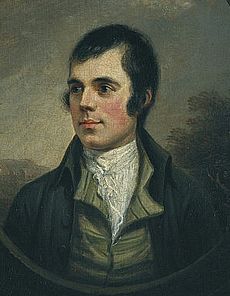January 25th is a day of celebration in Scotland. That’s because it’s Robbie Burns Day, the birthday of Scottish poet Robert Burns. In fact, this holiday is celebrated in many different places in the world—even in Vancouver, Canada!
In some places, Robbie Burns Day is known as Burns Night. This day is celebrated in many ways, ranging from bagpipe music to recitals of Burns’ poetry. In Scotland, this event is often represented by a formal party called a “Burns Supper,” which features the reading of a Burns poem called “Address to a Haggis.” Haggis is a Scottish meal that is made from a special recipe using the internal organs of sheep along with oatmeal, onions, and spices.
Robert Burns lived in the 18th century in Ayrshire, a rural area in Scotland. Burns is sometimes called the “ploughman poet” because he spent much of his life as a farmer. However, he was well educated, having studied Latin and French as well as the works of many important writers, such as William Shakespeare. He was introduced to many Scottish legends and folk songs by his mother.
 Robert Burns only lived to be 37 years old, yet he is the most famous poet from Scotland. His work influenced several famous poets who came later, including William Wordsworth, Percy Bysshe Shelley, and James Whitcomb Riley. Even the singer-songwriter Bob Dylan has said that Robert Burns’ poetry was a big influence on his song lyrics!
Robert Burns only lived to be 37 years old, yet he is the most famous poet from Scotland. His work influenced several famous poets who came later, including William Wordsworth, Percy Bysshe Shelley, and James Whitcomb Riley. Even the singer-songwriter Bob Dylan has said that Robert Burns’ poetry was a big influence on his song lyrics!
Robert Burns wrote many important poems in his lifetime. However, he is also remembered for helping to write down and publish Scottish folk songs. You have probably heard one of those songs before: “Auld Lang Syne,” which is commonly sung on New Year’s Eve in the United States. This song is about remembering old friends, and the title (which is in a Scottish dialect) means “times gone by.”
Some of Robert Burns’ poems are written in standard English, but many others were composed in a Scottish dialect. These poems use different spellings and vocabulary than you are used to seeing in poetry. One of Burns’ most famous poems is called “My Love is Like a Red, Red Rose.” It is actually based on a Scottish folk song. Here is the first part of the poem:
O my Luve’s like a red, red, rose
That’s newly sprung in June;
O my Luve’s like the melodie
That’s sweetly played in tune.As fair art thou, my bonnie lass,
So deep in luve am I;
And I will luve thee still, my dear,
Till a’ the seas gang dry.
The poem compares a young and beautiful woman to a freshly blooming rose. When Burns describes the rose as “newly sprung,” he means that it has just started to bloom.
In this poem, “fair” means “attractive,” and a “bonnie lass” is a beautiful young woman. “Till a’ the seas gang dry” means “until all the seas go dry.” In other words, the speaker is implying that he will love his young sweetheart forever.






